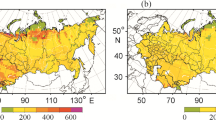Abstract—This article considers the problem of updating the maps of the agroclimatic zones of Russia and Kazakhstan, taking current climate warming into account. Agroclimatic zoning of a territory is one of the most important parameters of agroclimatic support of the economy; however, the problem of creating modern specialized maps on this topic and updating climate standards in Russia and Kazakhstan remains. Regional studies of the last few years on climatology and adaptation of agriculture to climate warming directly or indirectly indicate the need for updating climate standards and reference material (maps, diagrams, textbooks, etc.). In the course of this study, the sum of active temperatures (ΣT10) was calculated for 270 meteorological stations in Russia, Kazakhstan, and adjacent territories for the 2001–2018 period. The results recorded a noticeable shift in the boundaries of agroclimatic zones and an increase in ΣT10 by 200–600°C depending on the specific territory compared with data from the 1950s–1960s. The agroclimatic zones shifted to the greatest extent to 1600–2200 and 2200–2800°C, but Kamchatka, the Aral Sea region, and the Syr Darya basin are dominant in absolute value. The subtropical zone also expanded significantly beyond the Black Sea coast of Krasnodar krai, the southern coast of the Crimea and the extreme south of the Turkistan Region. The above information partially confirmed the forecast of Roshydromet in 2005, although in many regions of Russia the trend for ΣT10 to increase was slightly weaker than expected.




Similar content being viewed by others
REFERENCES
Zoidze, E.K., Khomyakova, T.V., Shostak, Z.A., Sirotenko, V.G., Ovcharenko, L.I., and Sukhareva, V.A., On the problem of adequate agroclimatic support of the economy of the Russian Federation in conditions of climate change, Meteorol. Gidrol., 2010, no. 8, pp. 73–86.
Agroklimaticheskie resursy Akmolinskoi oblasti: Nauch.-priklad. spravochnik (Agroclimatic Resources of the Akmola Region: Scientific and Applied Handbook), Baisholanov, S.S., Ed., Astana: Minist. Obraz. Nauki Resp. Kaz., 2017.
Shashko, D.I., Agroklimaticheskoe raionirovanie SSSR (Agroclimatic Zoning of the USSR), Moscow: Kolos, 1967.
Mishchenko, Z.A., Agroklimatologiya (Agroclimatology), Odessa: Odess. Ekol. Univ., 2006.
WMO Guidelines for the Calculation of Climate Norms, 2017, no. 1203. http://library.wmo.int/doc_num.php? explnum_id=4168. Accessed December 20, 2019.
Lebedeva, M.G., Krymskaya, O.V., and Chendev, Yu.G., Agroclimatic resources of the Belgorod region in the early 21st century, Dostizh. Nauki Tekh. APK, 2016, vol. 30, no. 10, pp. 71–76.
Mingalev, D.E., Regional aspects of global warming (on the example of the Pskov region), Materialy Mezhdunar. konf. “Problemy ustoichivosti ekologo-khozyaistvennykh i sotsial’no-kul’turnykh sistem transgranichnykh regionov” (Proc. Int. Conf. Problems of Sustainability of Ecological, Economic, and Socio-Cultural Systems of Transboundary Regions), Pskov: Pskov. Univ., 2014, pp. 177–196.
Kornyshev, D.S., Trends in the temperature regime of the territory and the strategy of agricultural production, Izv. Velikoluk. S-kh. Akad., 2015, no. 2, pp. 8–14.
Naumov, V.A. and Akhmedova, N.R., Changes in the duration of the growing season and the sum of active temperatures in the Kaliningrad region over the past ten years, Izv. Kaliningr. Tekh. Univ., 2016, no. 42, pp. 175–184.
Levitskaya, N.G. and Demakina, I.I., Modern climate changes in the Saratov region and the strategy for related adaptation of breeding and agricultural technologies, Usp. Sovrem. Estestvozn., 2019, no. 10, pp. 7–12.
Marmorshtein, A.A., Modern changes in heat supply indicators in the Krasnodar Territory, Nauchn. Al’m., 2017, nos. 1–3, pp. 335–338.
Polyakov, D.V., Modern changes in agroclimatic resources in the south-east of Western Siberia, Extended Abstract of Cand. Sci. (Geogr.) Dissertation, Tomsk, 2015.
Kuular, Kh.B., Regional climatic changes in the Tyva Republic, InterKarto/InterGIS: Mater. Mezhdunar. Konf., 2017, vol. 23, part 1, pp. 205–209.
Novorotskii, P.V., Climatic changes in the southern regions of the Khabarovsk Territory and the Jewish Autonomous Region, Probl. Reg. Ekol., 2013, no. 3, pp. 16–22.
Baisholanov, S.S., Pavlova, V.N., Zhakieva, A.R., and Chernov, D.A., and Gabbasova, M.S., Agroclimatic resources of Northern Kazakhstan, Gidrometeorol. Issled. Prognozy, 2018, no. 1, pp. 168–184.
Atoyants, V., Climate of Almaty acquires subtropical features. https://tengrinews.kz/kazakhstan_news/klimat-almatyi-priobretaet-chertyi-subtropicheskogo-ekspert-297166. Accessed January 10, 2020.
Vil'fand, R.M., Strashnaya, A.I., and Bereza, O.V., On the dynamics of agroclimatic indicators of sowing conditions, wintering, and the formation of the yield of the major grain crops, Tr. Gidrometeorol. Nauchno-Issled. Tsentra Ross. Fed., 2016, no. 360, pp. 45–78.
Mel'nik, V.I., Yatsukhno, V.M., Denisov, N., Nikolaeva, L., and Falaleeva, M., Agroclimatic zoning of the territory of Belarus taking into account climate change, 7-e zasedanie Mezhvedomstvennoi rabochei gruppy po problemam izmeneniya klimata (7th Meeting of the Interdepartmental Working Group on Climate Change Problems), Minsk, 2016.
Geograficheskii atlas dlya uchitelei srednei shkoly (Geographic Atlas for Secondary School Teachers), Kolosova, L.N., Ed., Moscow: GUGK, 1982, 4th ed.
Archive of Temperature and Precipitation by Cities of Russia and the CIS for the 21st Century and 2001–2005. http://thermograph.ru. Accessed January 14, 2020.
Climate Monitor of Russian Cities. http://www.pogodaiklimat.ru/monitor.php. Accessed January 16, 2020.
Strategicheskii prognoz izmenenii klimata Rossiiskoi Federatsii na period do 2010–2015 gg. i ikh vliyaniya na otrasli ekonomiki Rossii (The Strategic Forecast of Climate Change in the Russian Federation for the Period up to 2010–2015 and Their Impact on the Sectors of Russia’s Economy), Moscow: Rosgidromet, 2005.
Ranks, K., Pustynya Rossiya (Desert Russia), Moscow: Eksmo, 2011.
Köppen, W.P., Klassifikation der Klimatenach Temperatur, Niederschlag und Jahresablauf, Petermanns Geogr. Mitt., 1918, no. 64, pp. 193–203.
The Zone of Deserts of the Temperate Zone. http://www.geo-site.ru/index.php/2011-01-09-16-50-20/ 127-2011-09-23-19-46-52/657-ympystyna.html. Accessed January 13, 2020.
Climate Change in Russia in the 21st Century (Model CMIP5). http://voeikovmgo.ru/?option=com_ content&view=article&id=613&Itemid=236&lang=ru. Accessed March 24, 2019.
Author information
Authors and Affiliations
Corresponding author
Rights and permissions
About this article
Cite this article
Mingalev, D.E. Agroclimatic Zoning of Russia and Kazakhstan under Current Climate Change. Geogr. Nat. Resour. 42, 115–121 (2021). https://doi.org/10.1134/S1875372821020086
Received:
Revised:
Accepted:
Published:
Issue Date:
DOI: https://doi.org/10.1134/S1875372821020086




